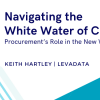Key Considerations in Developing Your Global Real Estate & Facilities Strategy
Corporate real estate executives faced with developing a global strategy for real estate and facilities services may find the task daunting. There can be substantial differences between a global strategy and a local or regional strategy. Even seasoned professionals find themselves challenged by the scale and complexities of time and distance. Combined with the wide variability of geography, culture, currency, language, laws and regulations, and the availability of qualified service providers, it becomes a puzzle of dizzying complexity.
Something as simple as scheduling a weekly team meeting can become a vexing exercise when team members are scattered across multiple global regions. Even within those global regions, distances may be immense. For example, an organization may define a region like APAC to include Japan, Indonesia and Australia with little thought about the 10 hours it can take to fly from Tokyo to Jakarta or 13 hours to fly from Jakarta to Sydney. Remember to consider time and distance when developing organizational structure and service delivery to ensure appropriate staffing to manage the locations effectively.
While much can be standardized within service offerings, service level expectations, pricing strategies and deal structures, there are components of local laws and regulations, differing tax structures and currency rules that must be considered. Should services be priced and paid for in the country in which they are performed, when possible, or is it more desirable to price services on a regional basis in a consistent currency? Understanding local laws and industry norms is important when making these decisions.
As the global marketplace for corporate real estate and facilities services has matured, the availability of qualified service providers, as well as the quality and consistency of services, has improved. Yet, the availability of qualified suppliers is far from universal. Depending on your geography and service needs, your strategy may require multiple providers. Also, remember that labor laws impact the way that services are delivered in different countries. A first-generation outsourcing initiative may require negotiations with local and federal governments, in addition to negotiations with unions, labor or work councils. Without a strong understanding of all the factors that will impact the strategy, plans to implement a single strategy globally can be easily derailed and cross-regional leveraging severely limited.
With all these challenges, it can be difficult to figure out where or how to start. A good starting point is to define and prioritize your drivers. Most organizations have similar drivers, like a desire to attract talent, improve service levels or reduce costs. You may want to rationalize a supplier base, increase the consistency of services and service delivery across geographies, increase reporting and data transparency, or increase standardization. You may want to increase flexibility and adaptability. Obviously, the potential list is long. By prioritizing drivers, you decide which are most important and which may have to be sacrificed to complete an initiative. This is also a perfect time to define metrics and develop benchmarks to measure the success of the initiative and the performance of service providers.
Next, decide what functions and tasks to include in the sourcing initiative. Determine which services should remain internal, which can be out-tasked as needed, and which should be subject to a comprehensive outsourcing arrangement.
Your plan must also account for specific goals, expectations or limitations that are internally driven. For example, are there specific financial goals that must be met? Who are the internal stakeholders, and what are their roles and expectations? Who has decision-making authority? What limitations will your organizational structure or the structure of your real estate team place on the configuration of any deal? Is restructuring desirable, or even an option? What is the capacity of your organization to manage transitions, and how will you allocate the time and resources to implement your strategy?
Development of a global sourcing strategy requires current and detailed market research to understand capabilities on a local, national and regional basis. In some cases, the unique configuration of your portfolio may require a complex matrix of service providers to cover the variety of services and service levels needed.
As you consider all these elements, your global strategy will begin to emerge. How your final plan is designed will have broad implications for the level of effort required to bid the project, the number of bidders, the complexity of the pricing model, and the number of contracts to be negotiated. Your global strategy will also determine the number and complexity of relationships that will need to be managed.
The global strategy you develop must align with your organization’s capacity to manage the implementation, the transition and the ongoing contracts and relationships that result. Do you have enough resources with the proper expertise and experience to be successful? Do they have the bandwidth to allocate the necessary time and energy to ensure the success of the initiative - and is it the best use of their time? If you need to build additional capacity, how does that affect your timeline, the expectation of other stakeholders and the business requirements? When is it more efficient to consider external expertise and resources? Remember that organizational capacity considerations aren’t limited to corporate real estate and facilities alone. You will need to rely heavily on other departments and resources as well, including a legal team, finance, and even HR and IT to succeed.
The bottom line is that each global corporate real estate and facilities services strategy will be unique. In a project this complex, there will be challenges that require a solution for which there is no prior precedent. Be flexible, and don’t be afraid to break new ground. You will be on your way to developing a successful global strategy.
Region:






